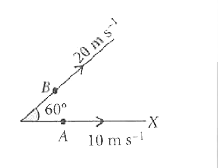Partical A moves along x -axis with a uniform velocity of magnitude 10 m/s . Particle B moves with uniform velocity 20 m/s along a direction making an angle of 60∘ with the positive direction of x-axis as shown in the figure 2.87 . The relative velocity of B with respect of that of A is

10 m/s along x-axis
10√3m/s along y-axis (perpendicular to x-axis)
10√5m/s along the bisection of the velocities of A and B
30 m/s along negative x-axis
The correct Answer is:B
∵cos60∘=12=1020
So, the third side of the triangle will be parallel ot the y-axis [Fig.2.88].

Length of the third side =√(20)2−(10)2=10√3
Therefore, relative velocity
of B with respect to that of A =10√3m/s along y-axis
Topper's Solved these Questions
- VECTORBOOK - CHHAYA PUBLICATIONCHAPTER - VECTOREXERCISE - EXAMINATION ARCHIVE WITH SOLUTIONS (AIPMT)
3 Videos
- VECTORBOOK - CHHAYA PUBLICATIONCHAPTER - VECTOREXERCISE - EXAMINATION ARCHIVE WITH SOLUTIONS (NEET)
4 Videos
- VECTORBOOK - CHHAYA PUBLICATIONCHAPTER - VECTOREXERCISE - EXAMINATION ARCHIVE WITH SOLUTIONS (WBCHSE)
19 Videos
- THERMOMETRYBOOK - CHHAYA PUBLICATIONCHAPTER - THERMOMETRYEXERCISE - EXAMINATION ARCHIEVE - WBJEE
1 Videos
- VISCOSITY AND SURFACE TENSIONBOOK - CHHAYA PUBLICATIONCHAPTER - VISCOSITY AND SURFACE TENSIONEXERCISE - EXERCISE (CBSE SCANNER)
9 Videos
Similar Questions
Two particles A and B start moving with velocities 20 m/s and 30√2 m/s along x-axis and at an angle 45∘ with x- axis respectively in xy-plane from origin the relative velocity of B w.r.t A
View SolutionTwo Particle A and B are moving with uniform velocities of 20m/sec and 10m/sec as shown in the shown in the figure. The Magnitude of angular velocity of A with respect to B.when their separation (AB) is 10 meter is
View Solution
Knowledge Check
Particle A moves along X-axis with a uniform velocity of magnitude 10 m/s. Particle B moves with uniform velocity 20 m/s along a direction making an angle of 60° with the positive direction of X-axis as shown in the figure. The relative velocity of B with respect to that A is
 A10 m/s along X-axisB10√3 m/s along Y-axis (perpendicular to X-axis)C10√5 m/s along the bisection of the velocities of A and B.D30 m/s along negative X -axis.
A10 m/s along X-axisB10√3 m/s along Y-axis (perpendicular to X-axis)C10√5 m/s along the bisection of the velocities of A and B.D30 m/s along negative X -axis.Two particles A and B start moving with velocities 20 m/s and 30√2 m/s along x-axis and at an angle 45∘ with x- axis respectively in xy-plane from origin the relative velocity of B w.r.t A
A(10ˆi+30ˆj) m/sB(30ˆi+10ˆj) m/sC(30ˆi−20√2ˆj) m/sD(30√2ˆi+10√2ˆj) m/sA motor car A is travelling with a velocity of 20m/s in the north-west direction and another motor car B is travelling with a velocity of 15m/s in the north-east directions.The magnitude of relative velocity of B with respect to A is.
A25m/sB15m/sC20m/sD35m/s
A car A moves with velocity 15ms−1 and B with velocity 20ms−1 are moving in opposite directions as shown in . Find the relative velocity of B w.r.t. A and w.r.t. B.
 .
.
View SolutionA car A moves with velocity 15ms−1 and B with velocity 20ms−1 are moving in opposite directions as shown in . Find the relative velocity of B w.r.t. A and w.r.t. B.
 .
.
View SolutionA motor car A is travelling with a velocity of 20 m/s in the north-west direction and another motor car B is travelling with a velocity of 15 m/s in the north-east direction. The magnitude of relative velocity of B with respect to A is
View SolutionAn object A is moving with 5 m/s and B is moving with 20 m/s in the same direction. (Positive x-axis). Find a) velocity of B relative to A.
b) Velocity of A relative to B
View SolutionIf a particle is moving with uniform velocity 20 m//s on a circular track of radius 10 m, then the magnitude of change in velocity in half revolution will be
View Solution
